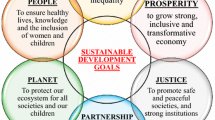Abstract
A considerable number of studies have been performed for improving the efficiency of production processes, of energy supply and utilisation, while reducing emissions of greenhouse gases, volatile organic compounds and other pollutants. This has been a very important task which this journal has been targeting. As a response to these industrial and societal requirements considerable research effort has been targeted to process integration and process intensification. This article has made an attempt for a short assessment of those advanced engineering approaches.
Similar content being viewed by others
References
Ahmed TY, Ahmad MM, Lam HL, Yusup S (2013) Hydrogen from renewable palm kernel shell via enhanced gasification with low carbon dioxide emission. Clean Technol Environ Policy. doi:10.1007/s10098-013-0606-6
Brau J-F, Morandin M, Berntsson T (2013) Hydrogen for oil refining via biomass indirect steam gasification: energy and environmental targets. Clean Technol Environ Policy. doi:10.1007/s10098-013-0591-9
Cal Gavin Ltd (2013). www.calgavin.com. Accessed 15 April 2013
CEFIC (2013) The European Chemical Industry Council. www.cefic.org. Accessed 16 April 2013
Čuček L, Klemeš JJ, Kravanja Z (2012) A review of footprint analysis tools for monitoring impacts on sustainability. J Clean Prod 34:9–20
DECHEMA (2013) Gesellschaft für Chemische Technik und Biotechnologie e.V. (Society for Chemical Engineering and Biotechnology). www.dechema.de/en/start_en.html. Accessed 12 April 2013
Deng C, Feng X, Wen Z (2013) Optimization of water network integrated with process models. Clean Technol Environ Policy. doi:10.1007/s10098-013-0609-3
EPIC (2013) European Process Intensification Conference. www.chemistryviews.org/details/event/2502531/EPIC_2013_-_European_Process_Intensification_Conference_EPIC_2013.html. Accessed 02 April 2013
ESCAPE 24 (2013) European Symposium on Computer Aided Engineering, Budapest, Hungary. www.escape24.mke.org.hu/home.html. Accessed 17 April 2014
EURECHA—The European Committee for the Use of Computers in Chemical Engineering Education (2013). bari.upc.es/eurecha. Accessed 18 April 2013
Gough M, Farrokpanah S, Bulatov I (2013) Retrofit process heat transfer enhancement to upgrade performance, throughput and reduced energy use. Clean Technol Environ Policy. doi:10.1007/s10098-013-0623-5
HEAT-int (2013) Process Integration Ltd, Manchester, UK. www.processint.com/chemical-industrial-software/heat-int. Accessed 16 April 2013
HEXAG and PIN online newsletter (2012) www.hexag.org/newsletter/index.html. Accessed 11 April 2013
Ho WS, Hashim H, Lim JS, Klemeš JJ (2013) Combined design and load shifting for distributed energy system. Clean Technol Environ Policy. doi:10.1007/s10098-013-0617-3
IChemE (2011) Advanced Chemical Engineering Worldwide, News archive, 21 June 2011, www.icheme.org/media_centre/news/2011/process%20intensification%20the%20time%20is%20now.aspx#.UXBG-kpChuM. Accessed 14 April 2013
INTHEAT—Intensified Heat Transfer Technologies for Enhanced Heat Recovery (2012). www.intheat.eu. Accessed 16 April 2013
Kapustenko P, Tovazhnyansky L, Arsenyeva O, Yuzbashyan A (2012) Mitigation of fouling in plate heat exchangers for process industries. Chem Eng Trans 29:1441–1446. doi:10.3303/CET1229241
Klemeš J (ed) (2013) Handbook of Process Integration (PI). Woodhead publishing series in energy No. 61. Woodhead Publishing, Cambridge. ISBN 9780857095930
Krishna Priya GS, Bandyopadhyay S (2012) Emission constrained power system planning: a Pinch Analysis based study of Indian electricity sector. Clean Technol Environ Policy. doi:10.1007/s10098-012-0541-y
Máša V, Bobák P, Kuba P, Stehlík P (2013) Analysis of energy efficient and environmentally friendly technologies in professional laundry service. Clean Technol Environ Policy. doi:10.1007/s10098-013-0618-2
Mikulčić H, Berg E, Vujanović M, Priesching P, Tatschl R, Duić N (2013) Numerical analysis of cement calciner fuel efficiency and pollutant emissions. Clean Technol Environ Policy. doi:10.1007/s10098-013-0607-5
Narodoslawsky M, Krotscheck C (2004) What can we learn from ecological valuation of processes with the sustainable process index (SPI): the case study of energy production systems. J Clean Prod 12:111–115
Ojha K (2010) Need of independent rural power producers in India: an overview. Clean Technol Environ Policy 12(5):495–501. doi:10.1007/s10098-009-0263-y
PINET (2013) Process intensification network. www.pinetwork.org. Accessed 12 Feb 2013
PRES—Process Integration, Modelling and Optimisation for Energy Saving and Pollution reduction (2013) www.confrence.pres.com. Accessed 03 March 2013
Reay D, Ramshaw C, Harvey A (2008) Process Intensification: Engineering for Efficiency, Sustainability and Flexibility. Butterworth-Heinemann, Oxford. ISBN 9780750689410
Reay D, Ramshaw C, Harvey A (2013) Process Intensification, Engineering for Efficiency, Sustainability and Flexibility, 2nd edn. Butterworth Heinemann, Oxford. ISBN 9780080983042
Shahzad K, Kettl K-H, Titz M, Koller M, Schnitzer H, Narodoslawsky M (2013) Comparison of ecological footprint for biobased PHA production from animal residues utilizing different energy resources. Clean Technol Environ Policy. doi:10.1007/s10098-013-0608-4
Wan Alwi SR, Tin OS, Mohammad Rozali NE, Abdul Manan Z, Klemeš JJ (2013) New graphical tools for process changes via load shifting for Hybrid Power Systems based on Power Pinch Analysis. Clean Technol Environ Policy. doi:10.1007/s10098-013-0605-7
Working Party of Computer Aided Process Engineering of European Federation of Chemical Engineering (2013) www.cape-wp.eu. Accessed 01 April 2013
Working Party on Process Intensification of European Federation of Chemical Engineering (2013) www.efce.info/Working+Parties/Process+Intensification/Home/Mission+Statement-p-111686.html. Accessed 12 Feb 2013
Zhu XX, Zanfir M, Klemeš J (2000) Heat transfer enhancement for heat exchanger network retrofit. Heat Transf Eng 2(21):7–18
Acknowledgments
The financial support from the Hungarian State and the European Union under project TAMOP-4.2.2.A-11/1/KONV-2012-0072 Design and optimisation of modernisation and efficient operation of energy supply and utilisation systems using renewable energy sources and ICTs is acknowledged.
Author information
Authors and Affiliations
Corresponding author
Rights and permissions
About this article
Cite this article
Klemeš, J.J., Varbanov, P.S. Process Intensification and Integration: an assessment. Clean Techn Environ Policy 15, 417–422 (2013). https://doi.org/10.1007/s10098-013-0641-3
Received:
Accepted:
Published:
Issue Date:
DOI: https://doi.org/10.1007/s10098-013-0641-3




